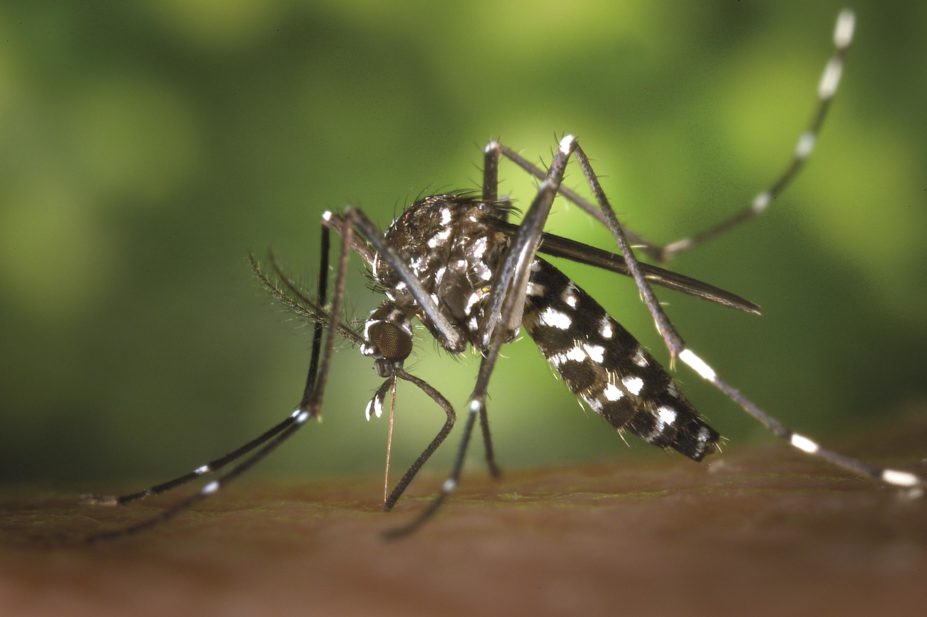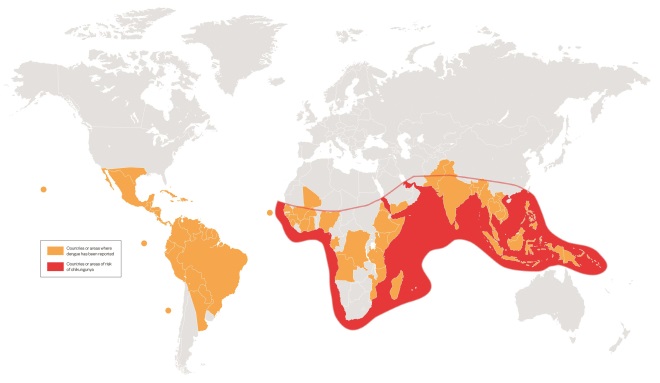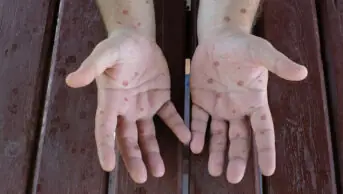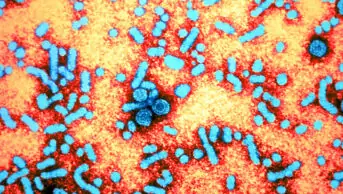
CDC / Wikimedia Commons
This article has been updated by The Pharmaceutical Journal team and reviewed by the expert authors to ensure it remains relevant and up to date, following this original publication. The updated version can be found here.
In short
Dengue fever and chikungunya are viral infections spread by types of mosquito. Both infections have similar symptoms, including fever, malaise and fatigue.
Patients should be referred to their GP if they present with any symptoms of dengue fever or chikungunya following overseas travel to areas where dengue, chikungunya or malaria are endemic. This referral should be urgent if the patient presents with fever or any severe symptoms.
There is no specific treatment for either dengue fever or chikungunya, and treatment for uncomplicated cases is symptomatic, with a focus on rehydration and pain relief.
Dengue fever and chikungunya are insect-borne viral diseases that can cause severe morbidity. They are both viral infections spread by the Aedes mosquito (in contrast to the Anopheles mosquito, which is associated with malaria). However, they are caused by different forms of virus; chikungunya is caused by a Togaviridae alphavirus, while dengue is caused by a Flavirideae flavivirus.
Both diseases are endemic in various areas in the tropics and overlap in distribution to a large extent with malaria, and their symptoms can make them difficult to distinguish from malaria in the early stages. Outbreaks also occur in regions often not associated with mosquito-borne diseases (e.g. the Caribbean), and cases have also been acquired locally in Southern Europe; in September 2014, there was a case of locally acquired dengue fever in the Côte d’Azur, France, and in August 2007, there was an outbreak of chikungunya in the Emilia Romagna region of Italy.

Countries and areas of risk of dengue fever and chikungunya
The risk of dengue fever and chikungunya is highest in tropical areas also associated with malaria. Areas of particular risk include Sub-Saharan Africa, South Asia and Central and South America.
Source: World Health Organization
Dengue fever
Dengue fever is one of the most common viral arthropod-borne diseases in the world, with an estimated 150 million infections and 25,000 associated deaths each year worldwide[1] (although the number of cases could be more than double this figure on account of underreporting). This represents a 30-fold increase in incidence over the past 50 years, which is due to a number of factors, including population growth, rural-urban migration, increases in discarded waste that can serve as mosquito breeding grounds, and global spread caused by increased international trade, particularly in used tyres that accumulate rainwater.
Infection rates have been estimated at 10–30 cases per 1,000 person-months in endemic areas
[2]
.
There were 541 confirmed reports of dengue in travellers returning to the UK in 2013, compared with 343 in the previous year; 69% of these cases originated in South and South East Asia and 16% in the Caribbean. This is likely to be a large underestimate of the actual number of cases.
Dengue fever is caused by a flavivirus for which humans are the chief host. Non-human primates also carry the disease, although cross-infection to humans is probably rare. Human-to-human transfer is via the Aedes.aegypti and Aedes.albopictus mosquitoes.
Four different serotypes of the flavivirus can cause a dengue infection; after infection, the patient is immune to causative serotype but reinfection with another serotype is still possible (and may be associated with more severe complications). Studies on cohorts of travellers have found high rates of sero-prevalence with a lower incidence of clinical infection, suggesting many cases are asymptomatic or mild and therefore not reported[2]
.
The incubation period of dengue fever is four to seven days (range three to 14 days)[3]
, and therefore symptoms in travellers starting more than 14 days after return are unlikely to be dengue. The initial symptom is fever, which may subside only to recur some days later. This lasts up to seven days, but recovery can take many weeks, accompanied by fatigue and malaise.
Other symptoms include severe headache, myalgia, back pain and abdominal tenderness. Joint and muscle pain may also be severe. A maculopapular rash occurs in 50–80% of cases. This usually appears on the trunk, spreading to the limbs and face[3]
. Adults may experience minor bleeding from mucous membranes such as the gums or nose.
Symptoms of dengue fever in children can be milder, and are often accompanied by diarrhoea and vomiting; however, children may be more prone to severe complications.
Dengue fever can affect the mechanisms of blood clotting and patients often develop thrombocytopenia. Although rare, it can also affect the function of other organs such as the liver and kidneys.
Severe dengue (previously termed dengue haemorrhagic fever) is a severe and potentially fatal complication characterised by widespread haemorrhage and extravasation of fluid, leading to hypotension and shock, and possibly organ damage including kidney and liver failure. Around a quarter of patients will die of dengue shock syndrome if not treated[4]
.
Severe dengue is rarely seen in travellers, and is more likely to occur in children in endemic areas, particularly those who have had dengue fever previously. This is believed to be because infection by a different dengue serotype results in a greater immunological response, and the various inflammatory mediators produced cause the symptoms of severe dengue[5]
. Travellers making frequent trips to dengue areas could be at increased risk of severe dengue, but so few cases have been reported in travellers that this has not been confirmed.
Chikungunya
Chikungunya was first recognised in the early 1950s in Tanzania. The name means ‘that which bends up’, a reference to the bent posture seen as a result of the associated arthritic symptoms.
Chikungunya is caused by a range of mosquito species. In Asia, it is principally transmitted by Aedes.aegypti
[6]
, and Aedes.albopictus, a species found in more temperate climates such as Southern Europe, is also known to carry the disease. In Africa, a range of species carry the disease, and it exists as an enzootic infection with a reservoir of the disease in primates and small mammals that can be passed to humans.
There have been a number of outbreaks of chikungunya in popular tourist areas. A major outbreak in the islands of the Indian Ocean in 2005 lasted for three years[7]
. Another outbreak occurred on St Martin in the Caribbean in 2013[8]
, and has now spread to most of the Caribbean and areas of Central and South America. Several islands in the Pacific also reported cases in 2014[9]
. There were 197 cases reported by the UK Public Health Authority in 2014, mostly originating from the Caribbean and South America[10]
.
Chikungunya shares very similar characteristics to the symptoms of dengue, but does not normally cause haemorrhagic complications (although some cases exhibiting haemorrhagic symptoms have been described in Asia). The distribution of the joint involvement and rash can help distinguish it from dengue (see ‘Signs and symptoms of chikungunya and dengue fever’).
Chikungunya has a short incubation period (two to four days), and can occur while travelling. The initial fever is accompanied by chills. This lasts for three to four days before remitting, and then reoccurs a few days later. The illness itself lasts for up to two weeks, and recovery can take a further few weeks. Most patients have no further complications, although arthritic symptoms can occur, which persist for up to a year, and some deaths have been reported among people living in endemic areas[11]
.
| Table 1. Signs and symptoms of chikungunya and dengue fever | ||
| Chikungunya | Dengue fever | |
| Typical time course | Incubation one to 12 days. Duration one to two weeks. | Incubation three to seven days. Duration four to seven days. |
| Initial symptoms | Fever, arthralgia, myalagia, headache, conjunctival injection, photophobia, rash. | Fever, arthralgia, rash, headache. |
| Arthralgia and myalgia | Polyarthritis, symmetrical typically involving the smaller joints (e.g. hands and feet), with swelling. Pain is worse in the mornings. | Severe myalgia of the lower back, arms and legs. Arthralgia, especially of the knees and shoulders. |
| Distribution of rash | Flushing on face and trunk. Widespread rash (50% of cases) on trunk and limbs that can also affect face, palms and feet accompanied by pruritus. | Limbs and face. |
| Complications | Around 5–10% of patients will develop chronic arthritis. Rarely neurological complication. | Severe dengue fever may cause shock, respiratory distress, haemorrhagic complications and organ impairment. |
Treatment
Patients should be referred to their GP if they present with any symptoms of dengue fever or chikungunya following overseas travel to areas where dengue, chikungunya or malaria are endemic. This referral should be urgent if the patient presents with fever or any severe symptoms. Travellers who develop a fever while still in the tropics should seek medical help as soon as possible.
There is no specific treatment for either dengue fever or chikungunya, and treatment for uncomplicated cases is symptomatic, with a focus on rehydration and pain relief.
Rehydration is important in all cases of fever, particularly in hot climates, where patients should be treated with oral rehydration therapy as required. Patients with severe dengue should be treated with parenteral rehydration.
Patients with dengue should use paracetamol for analgesia; non-steroidal anti-inflammatory drugs (NSAIDs) should be avoided in dengue fever because of the risk of haemorrhagic complications. Patients with chikungunya who develop arthritic symptoms can be treated with NSAIDs, but they should be monitored closely as the disease can sometimes cause thrombocytopenia
[6]
.
Prevention
There are no marketed vaccines yet available for either dengue fever or chikungunya. One promising candidate for dengue fever, a live-attenuated tetravalent vaccine based on chimeric yellow fever-dengue virus (CYD-TDV), is in early clinical trials.
The most important measure that a traveller can take against these diseases is the use of bite avoidance measures throughout the day; the Aedes mosquito is referred to as a ‘daytime’ feeder, and tends to be more active during the cooler parts of the day, such as early morning and late afternoon.
Covering up exposed skin is important and using insecticide impregnated clothing should be considered. Travellers should be advised to apply a 50% DEET-based repellent to exposed skin; alternative preparations containing icaridin, lemon eucalyptus and p-menthane-3,8-diol (PMD) or IR3535 are also effective.
References
[1] Wilder-Smith A. Dengue in international travellers: Quo Vadis. J Trav Med 2013;20:141–143.
[2] Ratnam I, Leder K, Black J et al. Dengue and International Travel. J Trav Med 2013;20:384–393.
[3] Pooja C, Amrita Y & Viney C. Clinical implications and treatment of dengue. Asia Pacific J Tropical Med 2014;169–178.
[4] World Health Organization. Dengue guidelines for treatment, prevention and control. Geneva: World Health Organization 2009.
[5] Simmons CP, Farrar JJ, Chau NV et al. Current Concepts: Dengue. New Engl J Med 2012;366:1423–1432.
[6] Seneviratne S, Gurugama P & Perera J. Chikungunya viral infections: an emerging problem. J Trav Med 2007;14:320–325.
[7] Health Protection Agency. Cikungunya virus in the Indian Ocean. CDR Weekly 2006;16(6).
[8] Public Health England. Chikungunya cases increase in the Caribbean. 28 November 2014.
[9] Public Health England. Health protection guidance: Chikungunya. 25 April 2014.
[10] Public Health England Chikungunya in England Wales and Nothern Ireland: 2013.
[11] Burt F, Rolph MS, Rulli N et al. Chikungunya: a re-emerging infection. The Lancet 2012;379:662–671.


